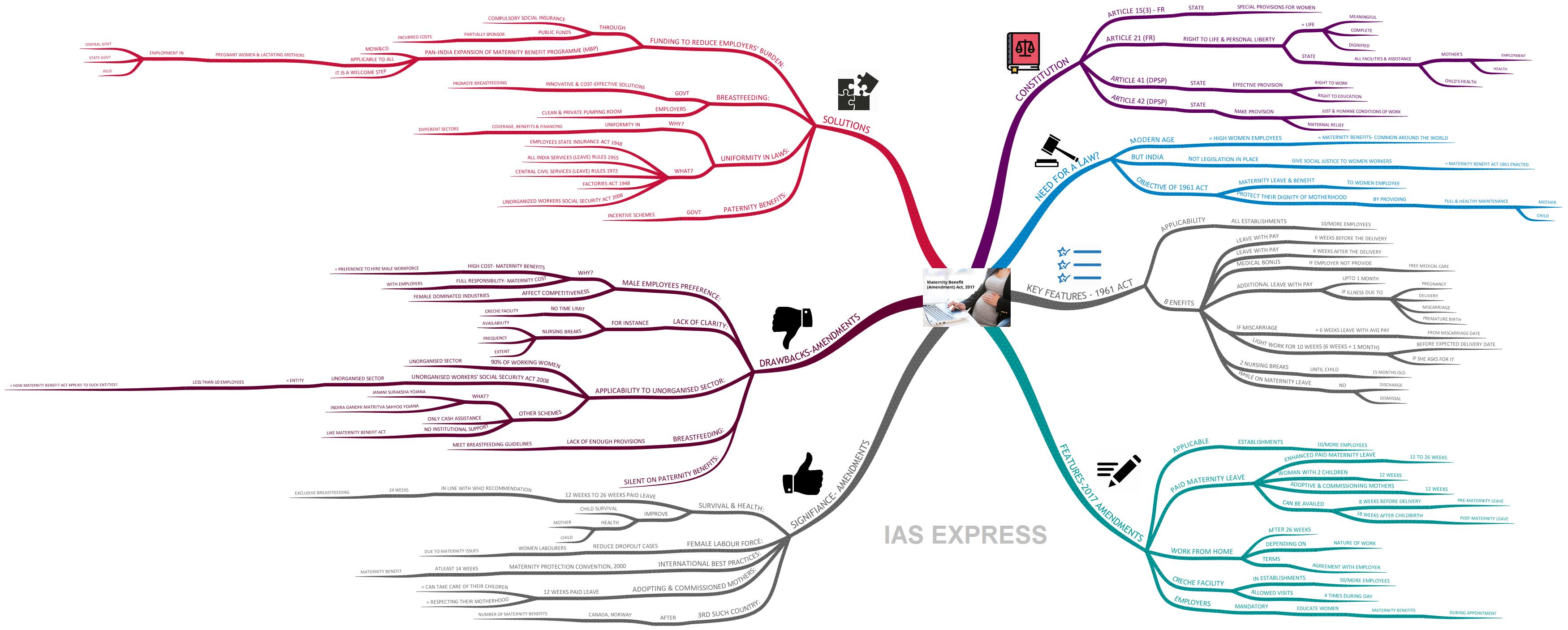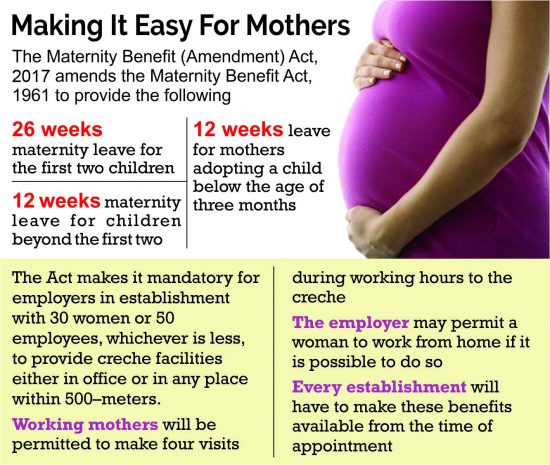Maternity Benefit (Amendment) Act 2017 – Pros and Cons

From Current Affairs Notes for UPSC » Editorials & In-depths » This topic
IAS EXPRESS Vs UPSC Prelims 2024: 85+ questions reflected
In order to protect the rights of women employees during pregnancy and after childbirth, Indian law makes it mandatory for most establishments to offer maternity benefits to women employees.
Maternity benefit in India is mainly governed by the Maternity Benefit Act, 1961 that applies to all shops and establishments with 10 or more employees. Maternity Benefit (Amendment) Act, 2017 further increased the maternity benefits being provided under the Act.
Maternity benefit and Indian Constitution
- Article 15(3) of the Indian Constitution empowers the State to make special provisions for women. The main objective of Article 15 (3) is based on “protective discrimination” keeping in view the weak physical position of women.
- Article 21 – Right to Life and Personal Liberty means the right to lead a meaningful, complete and dignified life. It does not have restricted meaning. Therefore, the State must guarantee to a pregnant working woman all the facilities and assistance that she requires while protecting her employment as well as her own and her child’s health.
- The Directive Principles of State Policy contained in Part IV of the Constitution of India, under Article 41 requires the State to make effective provision for securing the right to work and to education.
- Article 42 requires that the State shall make provision for securing just and humane conditions of work and for maternity relief.
What was the need for a law?
- With the advent of the modern age, as the number of women employees is increasing, the maternity leave and other maternity benefits are increasingly becoming common around the world.
- However, there was no beneficial piece of legislation in this respect which seeks to achieve the objective of giving social justice to women workers employed in factories, mines, and plantation. Hence the Maternity Benefit Act was enacted.
- The objective of Maternity Benefit Act 1961 was to provide maternity leave and benefit to women employee and protect their dignity of motherhood by providing for the full and healthy maintenance of women and her child.
What are the key features of the Maternity Benefit Act 1961?
The 1961 Act seeks to regulate the employment of women in some establishments for a particular period before and after childbirth and to provide for maternity benefit and certain other benefits.
Applicability:
The act is applicable to all establishments employing 10 or more employees – factories, mines, plantations, Government establishments, shops and establishments under the relevant applicable legislation, or any other establishment as may be notified by the Central Government.
Benefits under the Act:
- Leave with average pay for 6 weeks before the delivery.
- Leave with average pay for 6 weeks after the delivery.
- A medical bonus if the employer does not provide free medical care to the woman.
- An additional leave with pay up to 1 month if the woman shows proof of illness due to the pregnancy, delivery, miscarriage or premature birth.
- In the case of miscarriage, six weeks leave with average pay from the date of miscarriage.
- Light work for ten weeks (six weeks plus one month) before the date of her expected delivery, if she asks for it.
- Two nursing breaks in the course of her daily work until the child is 15 months old.
- No discharge or dismissal while she is on maternity leave.
What are the salient features of Maternity Benefit (Amendment) Act 2017?
The Maternity Benefit (Amendment) Act 2017 has made amendments to the Maternity Benefits Act, 1961. The major aim of the amendment Act is to regulate the employment of women during the period of childbirth. It has amended the provisions related to the duration and applicability of maternity leave, and other facilities.
- The act is applicable to all those women employed in factories, mines, and shops or commercial establishments employing 10 or more employees.
- It enhanced the duration of paid maternity leave available for women employees from 12 weeks to 26 weeks.
- However, for those women who are expecting after having 2 children, the duration of the leave remains unaltered at 12 weeks.
- It extended the benefits to the adoptive and commissioning mothers by providing them 12 weeks of maternity leave from the date of adoption. Note: The commissioning mother has been defined as a biological mother who uses her egg to create an embryo planted in any other woman or surrogate mother.
- The paid maternity leave can be availed 8 weeks before the expected date of delivery. Before the amendment, it was 6 weeks. Remaining 18 weeks can be availed post childbirth.
- The Act has introduced an enabling provision relating to “work from home” that can be exercised after the expiry of 26 weeks leave period. Depending upon the nature of work, a woman can avail of this provision on such terms that are mutually agreed with the employer.
- The amended Act has mandated a crèche facility for every establishment employing 50 or more employees. The women employees should be permitted to visit the facility 4 times during the day.
- The amended act makes it compulsory for employers to educate women about the maternity benefits available to them at the time of their appointment.
What are the significances of the amendments?
Survival and Health of Mother and Child:
- The amended act has increased the maternity benefits from 12 weeks to 26 weeks. This is significant and is in line with the recommendation of the World Health Organisation which mentions that children should be exclusively breastfed by the mother for the first 24 weeks.
- Thus the increase in the maternity leave will aid in improving survival rates of children and healthy development of both mother and child.
Female Labour force participation: The amendment will reduce the cases of women dropping out of the labour force because of the lack of adequate maternity leave.
International best practices: The amended act also falls in line with international best practices like the Maternity Protection Convention, 2000 (No 183) which calls for at least 14 weeks of mandatory maternity benefit.
Adopting & commissioned mothers: Another significant feature is the introduction of 12 weeks of maternity benefits to the adopting and commissioned mothers enabling them to take care of their children thus respecting their motherhood.
Third such country: The amended provisions have placed India third worldwide only behind Canada and Norway globally in the number of maternity benefits being made available to the women workers.
What are the drawbacks of the amendments?
Male Employees Preference:
- The increase in maternity leave could also have an adverse impact on job opportunities for women.
- (The mandatory full payment of wages during maternity leave + provisioning of the creche and other facilities) = could increase costs for employers = their hiring preference would be in favour of male workers.
- The provision could also affect the competitiveness of industries that mainly employ women workers.
- A 2014 International Labour Organisation report specifically cautions against making employers solely liable for the cost of maternity benefits for these reasons.
Lack of Clarity:
- Several provisions of the amended act lack clarity.
- For instance, there is no clarity with respect to the time period up to which the crèche facility could be extended to the employee and also regarding the availability, frequency, and extent of nursing breaks.
Applicability to unorganised sector:
- The provisions related to the applicability of the Act to the unorganised sector also remain unclear.
- Though, on one hand, the act states that it covers all women working in mines, plantations, shops, and establishments as well as factories in both organised and unorganised sectors.
- But on the other hand, the Unorganised Workers’ Social Security Act, 2008 defines unorganised sector workers as those who are home-based, self-employed, or wage workers working in an entity having less than 10 employees.
- Thus the provisions did not clarify whether the act is applicable to the women employees in those enterprises having less than 10 employees.
- This is disturbing considering the fact that 90% of the working women are employed in unorganised sector in India.
- Although the women working in unorganised sector can avail benefits from the schemes such as the Janani Suraksha Yojana and the Indira Gandhi Matritva Sahyog Yojana, they get their benefit only in terms of cash assistance and lack other institutional support provided in the maternity benefit act.
Lack of enough provisions to meet the breastfeeding guidelines:
- Studies have shown that health benefits that accrue to both the mother and her child by breastfeeding are more than matched by economic returns at family, enterprise and national levels.
- However, India spends a measly amount of $0.15 (less than ₹10) per child to ensure that it meets the breastfeeding guidelines.
- As a result, India is going to lose an estimated $14 billion in its economy due to the high level of child mortality and the growing number of deaths in women from cancers and Type II diabetes, which is directly attributable to inadequate breastfeeding.
Silent on paternity benefits:
- Currently, paternity benefits are allowed in government jobs as a part of leave rules and in private organizations as a matter of internal policy.
- ILO has also recognised men’s right to parenthood. It wants to see men as an active co-parent.
- In a country where gender stereotypes are predominant, a gender-balanced approach to parenthood is needed.
- But the amendment act is silent on this issue.
What could be done?
Funding:
- Maternity benefits can be provided either through compulsory social insurance or public funds.
- The government should create a corpus fund to partially sponsor the costs to be incurred by the employer to provide maternity benefits.
- In this regard, the Pan-India expansion of Maternity Benefit Programme (MBP) of the Ministry of Women & Child Development is a welcome step. The scheme is applicable to all pregnant women and lactating mothers and excludes the pregnant women and lactating mothers in regular employment with the Central Government or State Governments and in Public Sector Undertakings.
Breastfeeding:
- The government must find innovative and cost-effective ways to make sure that working women are not forced to discontinue breastfeeding. A simple solution is to store their breast milk so as to feed their children while they are away or at public places.
- Employers should provide a clean and private pumping room for breastfeeding purposes.
Competitiveness: the government should create some mechanism to make sure that the competitiveness of the private sector is not jeopardised by the Act.
The amalgamation of provisions in different laws:
- The government should try to create uniformity in labour laws regarding maternity benefits.
- The acts like Employees State Insurance Act, 1948, All India Services (Leave) Rules, 1955, Central Civil Services (Leave) Rules, 1972, Factories Act, 1948, and the Unorganized Workers Social Security Act, 2008 have differences in coverage, benefits, and financing.
- All these laws should be amalgamated to uniformly provide the benefits across different sectors in India.
Paternity benefits:
The government should come up with incentivised schemes regarding paternity benefits to achieve the objective of a gender-balanced approach to parenthood.
Overall, the amendments are a welcome and positive step by the government. But at the same time, the government must resolve the shortcomings and should work towards ensuring that the law provides equal opportunities to women at the workplace.
If you like this post, please share your feedback in the comments section below so that we will upload more posts like this.



